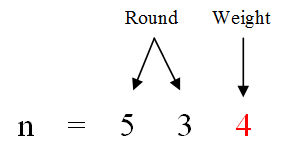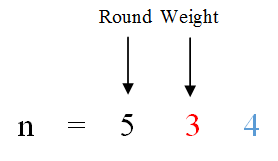Given an integer n, count the total number of digit 1 appearing in all non-negative integers less than or equal to n.
Example:
Input: 13 Output: 6 Explanation: Digit 1 occurred in the following numbers: 1, 10, 11, 12, 13.
1 public int countDigitOne(int n) { 2 StringBuffer s = new StringBuffer(""); 3 for ( int i = 1 ; i <= n ; i ++ ){ 4 s.append(""+i); 5 } 6 int count = 0; 7 for ( int i = 0 ; i < s.length() ; i ++ ){ 8 if ( s.charAt(i) == '1' ) count ++; 9 } 10 return count; 11 }
这里用StringBuffer可以降低内存操作时间,提高效率。不过还是不行,倒数第5个就超时了。
隆重介绍:找规律法。。。。
解题思路
考虑将n的十进制的每一位单独拿出讨论,每一位的值记为weight。
1) 个位
从1到n,每增加1,weight就会加1,当weight加到9时,再加1又会回到0重新开始。那么weight从0-9的这种周期会出现多少次呢?这取决于n的高位是多少,看图:

以534为例,在从1增长到n的过程中,534的个位从0-9变化了53次,记为round。每一轮变化中,1在个位出现一次,所以一共出现了53次。
再来看weight的值。weight为4,大于0,说明第54轮变化是从0-4,1又出现了1次。我们记1出现的次数为count,所以:
如果此时weight为0(n=530),说明第54轮到0就停止了,那么:
2) 十位
对于10位来说,其0-9周期的出现次数与个位的统计方式是相同的,见图:

不同点在于:从1到n,每增加10,十位的weight才会增加1,所以,一轮0-9周期内,1会出现10次。即rount*10。
再来看weight的值。当此时weight为3,大于1,说明第6轮出现了10次1,则:
如果此时weight的值等于0(n=504),说明第6轮到0就停止了,所以:
如果此时weight的值等于1(n=514),那么第6轮中1出现了多少次呢?很明显,这与个位数的值有关,个位数为k,第6轮中1就出现了k+1次(0-k)。我们记个位数为former,则:
3) 更高位
更高位的计算方式其实与十位是一致的,不再阐述。
4) 总结
将n的各个位分为两类:个位与其它位。
对个位来说:
- 若个位大于0,1出现的次数为
round*1+1 - 若个位等于0,1出现的次数为
round*1
对其它位来说,记每一位的权值为base,位值为weight,该位之前的数是former,举例如图:

则:
- 若weight为0,则1出现次数为
round*base - 若weight为1,则1出现次数为
round*base+former+1 - 若weight大于1,则1出现次数为
rount*base+base
比如:
- 534 = (个位1出现次数)+(十位1出现次数)+(百位1出现次数)=(53*1+1)+(5*10+10)+(0*100+100)= 214
- 530 = (53*1)+(5*10+10)+(0*100+100) = 213
- 504 = (50*1+1)+(5*10)+(0*100+100) = 201
- 514 = (51*1+1)+(5*10+4+1)+(0*100+100) = 207
- 10 = (1*1)+(0*10+0+1) = 2
参考:https://blog.csdn.net/yi_afly/article/details/52012593
在这里我总结了一下不需用分个位十位。直接统一看就好了。
1 class Solution { 2 public int countDigitOne(int n) { 3 int round = n; 4 int count = 0; 5 int base = 1; 6 while ( round > 0 ){ 7 int cur = round % 10; 8 round = round / 10; 9 count += round * base; 10 if ( cur == 1 ) count += ( n % base ) + 1; 11 else if ( cur > 1 ) count += base; 12 base *= 10; 13 } 14 return count; 15 } 16 }
运行时间0ms。